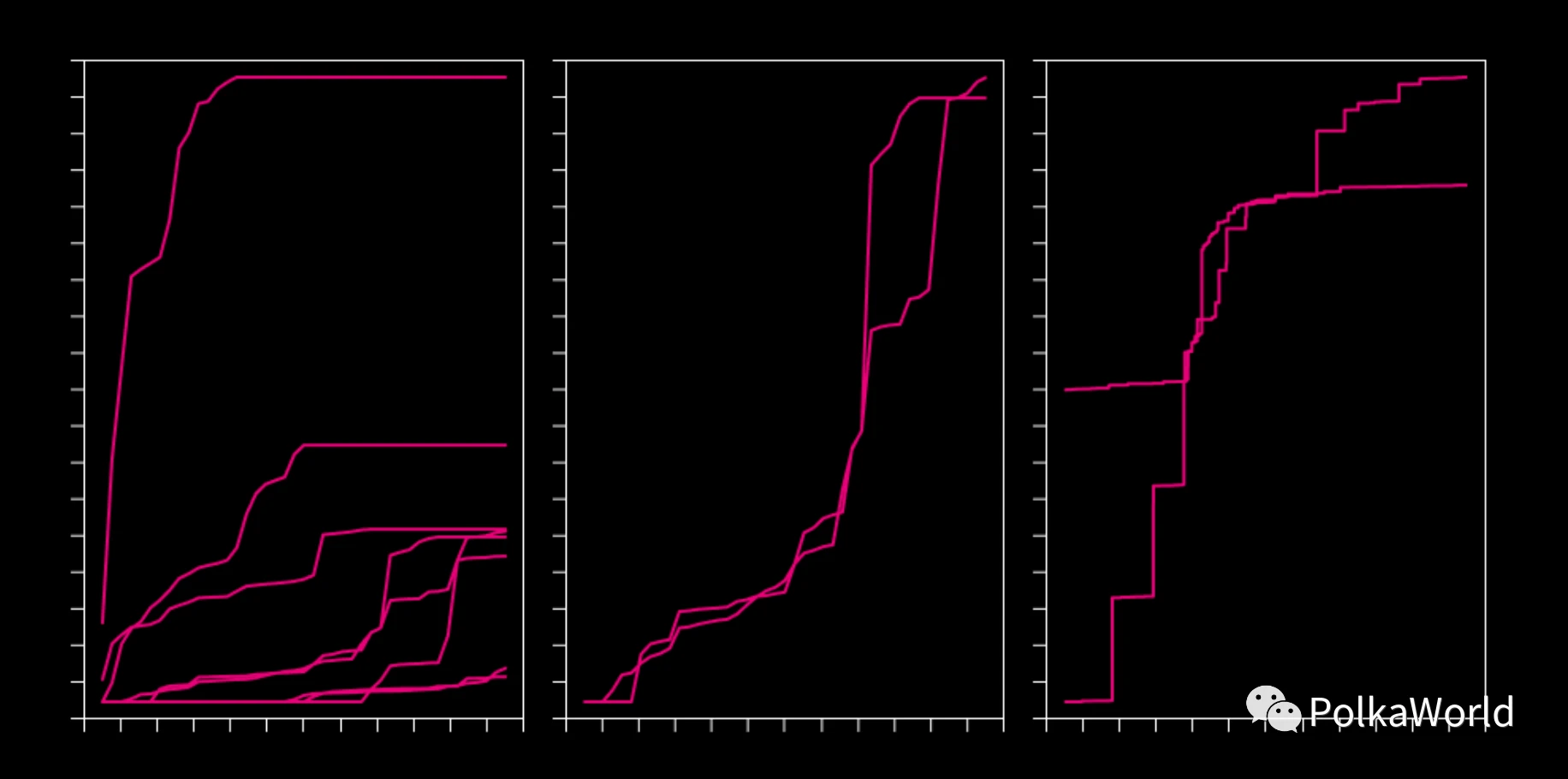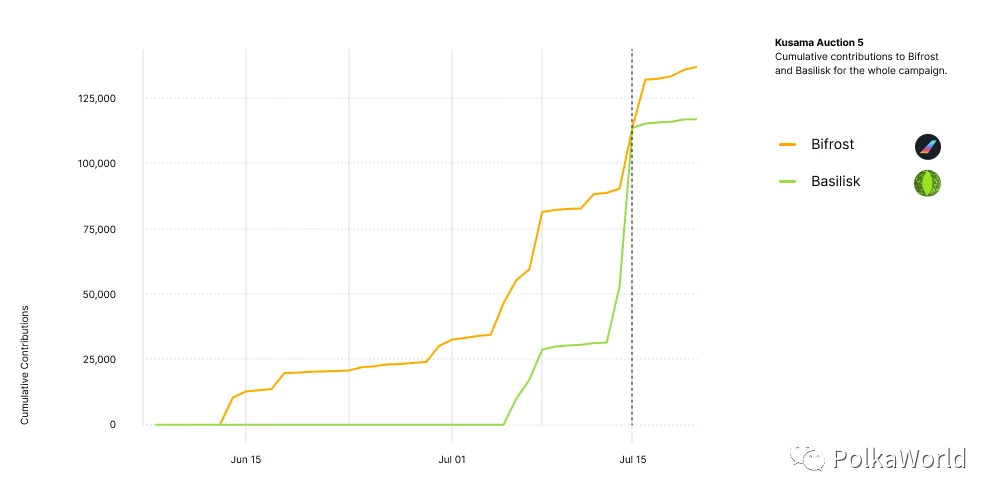Join the PolkaWorld community and build Web 3.0 together!

Join the PolkaWorld community and build Web 3.0 together!
Jonas Gehrlein, a research scientist at the Web3 Foundation, released an overview report on Kusama’s first round of parachain slot auctions yesterday, mainly introducing:
Review of the first round of 5 auctions, candle auctions and the Crowdloan mechanism
and the impact of the auction mechanism
The renewal of the future parachain and the dynamic events of the new parachain have analyzed and interpreted the influencing factors of the auction in two aspects
Due to the length of the original text, PolkaWorld organizes some essential points of view to facilitate everyone to understand important information.
Polkadot/Kusamas Candle Auction
The Candle Auction is an ancient auction format from around the 16th century that allows bids to be made before the candle is actually extinguished. Uncertainty about when the actual auction ends can reduce the problem of auction sniping at the last minute.

Unlike the ancient candlestick auctions, the final outcome of slot auctions in Polkadot and Kusama is determined retroactively. That is, auctions always have a fixed bidding time, after which the actual ending block (termination block) is randomly determined. We can mark four important points describing the time course of candle auctions in terms of block heights. As shown below.
The first phase of the auction lasts 27,000 blocks (approximately 45 hours), and during this initial phase, the team and users have time to get informed, gather information, and set their bidding/participation contribution strategies. After this, the candle phase (or end phase) marks the real start of the auction and lasts 72,000 blocks (roughly 5 days). At this stage, the auction can end at any block with equal probability. You can keep bidding until the auction ends! After the formal end, a termination block is computed using a combination of Verified Random Functions (VRFs). This way of calculating the termination block retroactively ensures that no one can predict the end time before or during the auction.
What is the Crowdloan mechanism?
The Crowdloan mechanism is a decentralized way for teams to gain support for bidding slots. That is to say, the tokens supporting crowdloan are collected by the team, but kept and protected by the relay chain. Users can withdraw their tokens in two situations:
The project you support successfully wins the parachain slot auction. Then after the lease period ends, you can receive your tokens
After the crowdloan of the project you support expires (usually very short), the situation of withdrawing tokens can also be terminated.
For supporting users who successfully bid for slots, your tokens incur an opportunity cost of being locked in the Relay Chain, e.g. foregone rewards due to staking or otherwise. So generally in order to thank you for your support for a certain project, the project party will use its own native tokens as compensation to reward everyone!
Review of Kusamas first slot auction
When the teams were surveyed, 10 out of 15 teams stated that their goal was to participate in Kusamas first auction. The majority of teams (80%) said they also planned to auction on Polkadot (13.3% of teams auctioned only on Kusama, 6.7% of teams auctioned only on Polkadot).
As of this writing, 47% of all issued KSM tokens are locked in staking and 9.9% are locked in crowdloan. Winners for the first five slots were Karura, Moonriver, Shiden, Khala and Bifrost.
Karura was the one who outshone all other teams by a wide margin from the start. Moonriver started out below the competition but quickly overtook Shiden before the start of the candle phase. That would give Shiden third place.

The graph below shows the dynamics of crowdloan contributions aggregated daily by the three projects.

Compared to the first three auctions, the 4th auction, especially before the candle phase, is more dynamic. The bidders were Bifrost and Khala. In this head-to-head game, the lead positions have been switching periodically, as shown in the graph below.
However, just as the candle phase started, Khala suddenly gained a lot of support and held the highest bid across all blocks. In the end Khala won the fourth parachain slot on Kusama.

At the time of the fifth auction, at first we thought it would be an easy win, as no other project came close to Bifrosts bid. However, a competitor called Basilisk declared stiff competition for Bifrost before the fourth auction began. Basilisks crowdloan did gain traction and soon caught up with Bifrost. Vertical dotted lines indicate the start of candle phases.
While Basilisk started the candle phase with the highest bid, Bifrost ended up being the highest bidder in 96.6% of the blocks in the candle phase, meaning Bifrost had a 96.6% chance of winning. In the end, we didnt see any big surprises, and Bifrost managed to secure its fifth auction.
Candle auction mechanism incentivizes early bidding
But in general, the auction mechanism is to incentivize each bidder to bid as early as possible. Taking the data of the first auction as a representative, it is not difficult to see that most of the contributions are made before the candle phase. So, the candle mechanism successfully incentivizes early bids.
in conclusion
in conclusion
The slot auction for the Kusama network is an exciting time for the entire Polkadot ecosystem and the blockchain industry as a whole. With the advent of parachains, we have taken a giant step toward a scalable, decentralized, and interoperable future. The first five live projects are Karura, Moonriver, Shiden, Khala, and Bifrost. These projects will add powerful capabilities to the Kusama ecosystem by providing infrastructure for DeFi, liquidity solutions, smart contracts (native and EVM compatible), private cloud computing, and more.
1. Two characteristics of the candle auction mechanism
Through the overall results of the auction, the foundation found that Kusama/Polkadots candle auction mechanism has two characteristics. First, it guarantees efficiency, that is, it determines that the bidder with the highest bid can win the auction, and it is a fair process; The second is that the so-called income will not be created in the process of slot auction, because this is a decentralized process, and there is no so-called profitable entity!
2. Winning an auction is more important than minimizing bids
Another observation is that, especially for Karura who is the first to win the slot, too many tokens are bonded. In theory, this might be considered suboptimal. But we must take into account an objective factor, that is, the primary goal of all the teams currently bidding is to launch online!
So at this stage, winning the auction is more important than minimizing bids. And there are some advantages to doing so, first you can distribute tokens to as many supporters as possible; second more support also means that the project is more valuable to the ecosystem!
3. Multiple bidders can share the lease period
Candle auctions can also be used to share lease periods, that is, multiple bidders share a lease period. While we havent seen this happening yet, its because the teams currently bidding on it want to bid on the entire rental slot! So it is to be expected that at this stage of the auction, any bid for less than the full lease term is doomed. And in the previous survey, 80% of the participants indicated that they would bid for the full lease term!
4. A crowdloan that votes may fail is an economically costly decision
Except for the 5th auction, the other four auctions already had a very leading crowdloan before the start of each candle phase. Voting on a crowdloan that is likely to fail is an economically expensive decision since the tokens will be locked for at least the entire duration of the campaign. Users not only need to choose their favorite team, but also need to evaluate which team is likely to win. Especially late in the campaign, some teams have an increasingly difficult time catching up to the leading teams, so their rational choice is to either contribute to other crowdloan-winning projects, or not participate at all. Over time, this justification may increase the distance between the teams.
prediction of the future
It is expected that in the future, we will experience from no parachains to some parachains that need to extend the lease period to maintain operations, and at the same time there will be other new parachains that will bid for the first time to join. This creates a series of dynamic events that affect two main aspects, the mechanics of contributions and how bidding strategies are used in auctions.
Contribution Mechanism
After talking to some parachain teams, we found that the crowdloan auction format is still an important part of their future economy. Some innovative teams are already looking for more suitable alternative contribution mechanisms. One possible direction is a variant of the crowdloan module that exploits chain interoperability. For example, users can deposit their parachain native tokens into a smart contract which automatically swaps them for relay chain tokens (i.e. KSM or DOT) via a decentralized exchange (DEX) parachain. Smart contracts can then automatically use these tokens to bid in auctions. In addition to parachain native tokens, with the upcoming ethereum-bitcoin bridge, it is even possible for smart contracts to use ETH (and erc20 tokens) and BTC.
As the initial native supply of tokens is eventually fully distributed, it will become increasingly difficult to reward contributors to the platform. Similar to the smart contract solutions described previously, parachains could evolve into decentralized autonomous organizations (DAOs) that raise tokens during their operations and accumulate them in their on-chain treasury. Eventually, to ensure preservation, the chain may start accumulating relay chain tokens in this way for extended leases. This means that the chain itself will become more and more self-sufficient.
Auction Bidding Bidding Strategies
As mentioned earlier, the go-live phase is a unique situation in the network where minimizing bids is not the most important factor. As such, we see most teams focusing on bonding as many tokens as possible, rather than using the optimal bid. However, once the network reaches the scaling phase, some parachains will need to extend leases and compete with new projects that are entering the auction for the first time. In this case, flexible bidding, i.e. bidding to minimize bids for projects, is an important factor in effectively maintaining the parachain.
In conclusion, through the slot auction, the team has the opportunity to benefit from Kusama and Polkadots infrastructure and start to realize their vision. In a sense, this helps incentivize projects to continue their efforts, as teams look to demonstrate that they have a significant presence in the ecosystem.
Follow Substrate progress:
Welcome to learn Substrate:
https://substrate.dev/
Follow Substrate progress:
https://github.com/paritytech/substrate
Follow Polkadot progress:
https://github.com/paritytech/polkadot










